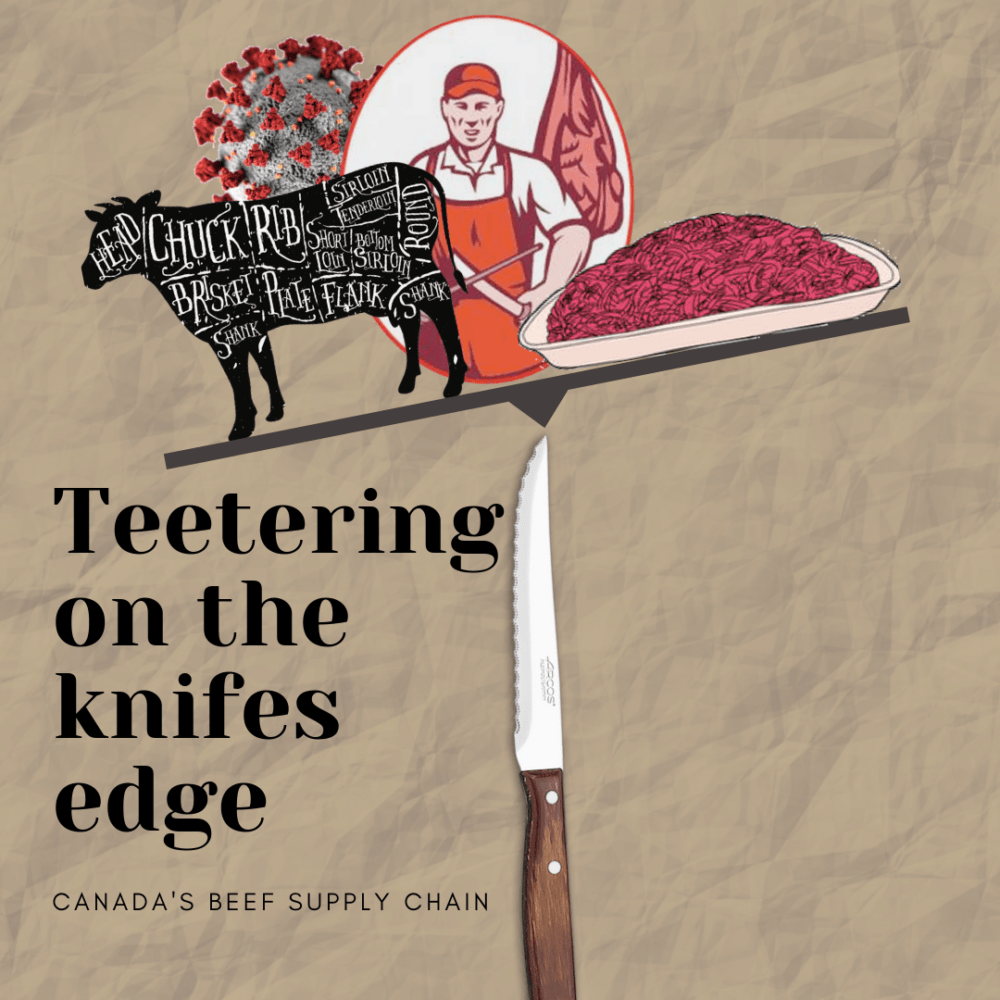Why Canada’s robust, but fragile, beef supply chain needs a revamp
By: Judson Christopherson, University of Saskatchewan student
Loads of Local Beef, A Lack of Local Beef Processors
As a western Canadian Rancher, I have seen firsthand the lack of options we as producers have for marketing large volumes of finished cattle. Very few options exist outside of the massive Alberta plants owned by JBS and Cargill (National Farmers Union, 2020). These companies have earned their near-monopolies in meat processing, with the two aforementioned plants and a third Cargill plant in Guelph, Ontario accounting for over 95% of the beef processed in Canada according to the National Farmers Union (2020).
This near monopolization of Canada’s beef supply chain has left little room for smaller firms to gain traction in accumulating market share. This is not always a bad thing, as North American consumers count on reasonably priced food to feed their families. According to an article by Collins and Seskus, the massive economies of scale realized by these plants allow them to provide beef to consumers much cheaper than smaller plants (2020). However, there are negative implications to the market power held by these abattoirs for producers and consumers alike. During the COVID-19 pandemic, many of these plants had to idle production or shut down entirely leading to producers receiving less for their animals. The lack of mid-sized local beef processors ensured that there was minimal available supply to offset the shortfall of the large abattoirs. This caused a sharp spike in grocery store beef prices. This calls into question whether these packers have too much power in deciding what producers receive, and what consumers pay.
The Implications for Producers and Consumers
The robust, labour-intensive, close-quarters nature of these few large plants can cause lead to major issues (Gowriluk, 2020). With cattle being delivered live to the plant, killed, hung, and cut into smaller pieces (ranging from finished cuts to quarters) in the matter of a few weeks, the opportunity for on small mistake to become a massive recall is alarming. Oftentimes this is exposed through small spots of bacteria such as E. coli causing major beef recalls (USDA, 2018). This furthers the point of Temple Grandin’s quote “big is not bad, it is fragile” (Grandin, 2020). Most recently a new fragility has been exposed. According to Collins and Seskus the quick spread of COVID-19 through these plants, and numerous others similar to them, led to a large live beef backup of over 100,000 head in Alberta alone. This caused a major shortfall beef supply chain when the plants reduced capacity (2020).
The result was many producers losing money on cattle they worked tirelessly to raise from birth to finish, maintaining ownership of these animals for up to 18 months, and investing over $1500, to have them ready to market. While consumers were left paying more in the grocery aisle to feed their family. So, who reaped the rewards? It sure appears as though the shutdowns and capacity idling of these plants benefitted JBS and Cargill. According to research
done by Jessica Fu, the USDA states these large beef abattoirs also realize large profit margins on the beef they do slaughter, oftentimes reaching $66 per hundred pounds processed. However, during the pandemic, this number skyrocketed to $279 per hundredweight as producers received up to 40% less for their animals, and consumers saw prices almost double in some jurisdictions (2020). These large profits do not coincide with the investment these plants have in the animals, as they are able to take them from the auction barn to a retail shelf in mere weeks. Not to undermine the effect that COVID had on the abattoirs themselves, with hundreds of cases and several deaths in the Alberta plants. The outbreaks also led to less available workers, while costs remained the same. This undoubtedly caused the costs per head processed to increase. However, the high profits realized by abattoirs are unfair to producers and consumers who were both hit hard financially by the pandemic.
Building a Better Beef Supply Chain
The purpose of this blog is to gradually and carefully modify the beef supply chain to make room for smaller firms to gain market share. We do not need a rapid reaction as a result of the pandemic as the outcome would likely not be favourable for producers, processors, or consumers. However, the beef supply chain is long overdue for modification, and the COVID-19 pandemic thrust this point into the public sphere. The changes can, at first, be consumer-driven by making the decision to source beef products from local butchers and meat shops. Apps such as Regina-based Meatocracy, which connects producers and consumers with the goal of shortening the beef supply chain in a “Farm To Freezer” fashion are a great place to start. Widespread consumer adoption of platforms like Meatocracy could prove to have a large impact on Canada’s domestic beef market.
Alongside consumer adoption, we need policies that make opening a mid-size (500 head/week) easier. This could come in the form of start-up grants that are non-repayable if the business is still operational after five years. The goal is not to run JBS or Cargill out of business but to give them competition. At the same time giving ranchers more options when deciding what is best for their operations. If this can be achieved, we will most likely see improvements on all levels of the beef supply chain.
[su_accordion][su_spoiler title=”References” open=”no” style=”default” icon=”plus” anchor=”” class=””][su_list icon=”icon: check” icon_color=”#47907C”]
Works Cited
- Collins, E., & Seskus, T. (2020, May 18). Why some think Canada’s beef business needs more smaller players | CBC News. Retrieved September 22, 2020, from https://www.cbc.ca/news/business/canada-meat-processors-industry-covid-beef-1.5568730
- Fu, J. (2020, July 24). Beef packers’ profit margins reached historic levels during the height of Covid-19 plant shutdowns. Retrieved September 24, 2020, from https://thecounter.org/beef-packers-profit-margins-reached-historic-levels-covid-19-plant-shutdowns/
- Gowriluk, C. (2020, June 07). End to slaughterhouses would benefit workers, consumers – but it’s unlikely even COVID-19 will force change | CBC News. Retrieved September 24, 2020, from https://www.cbc.ca/news/canada/manitoba/manitoba-slaughterhouse-covid-19-1.5599837
- Grandin, T. (2020, May 03). Temple Grandin: Big Meat Supply Chains Are Fragile. Forbes.com. Retrieved September 24, 2020, from https://www.forbes.com/sites/templegrandin/2020/05/03/temple-grandin-big-meat-supply-chains-are-fragile/#4503cb8a650c
- National Farmers Union. (2020, April 22). Meat packing concentration makes Canada’s food system vulnerable. Retrieved September 24, 2020, from https://www.nfu.ca/wp-content/uploads/2020/04/2020-04-21-Concentration-of-meat-packing-makes-Canada-vulnerable.pdf
- USDA. (2018, September 19). Food Safety and Inspection Sercive. News Release, Cargill Meat Solutions Recalls Ground Beef Products due to Possible E. coli O26 Contamination. Retrieved September 21, 2020, from https://www.fsis.usda.gov/wps/portal/fsis/topics/recalls-and-public-health-alerts/recall-case-archive/archive/2018/recall-081-2018-release
Bibliography
- Government of Canada. (2012). North American Industry Classification System (NAICS) Canada 2012. Retrieved September 24, 2020, from https://www23.statcan.gc.ca/imdb/p3VD.pl?Function=getAllExample&TVD=118464&CV D=118471&CPV=311611&CST=01012012&CLV=5&MLV=5&V=77951&VST=010120 12
- Heneghan, C. (2015, October 26). By the numbers: A dive into food, beverage manufacturing
- wages. Retrieved September 24, 2020, from https://www.fooddive.com/news/by-the-numbers-a-dive-into-food-beverage-manufacturing-wages/407752/
- Rude, J., Harrison, D., & Carlberg, J. (2010). Market Power in Canadian Beef Packing. Canadian Journal of Agricultural Economics/Revue Canadienne D’agroeconomie, 59(3), 321-336. doi:10.1111/j.1744-7976.2010.01204.x
[/su_list] [/su_spoiler][/su_accordion]

Judson Christopherson
Hi, I’m Judson Christopherson. I grew up on the family ranch west of Yellow Grass, Saskatchewan, where I still reside today. I am enrolled in my third year of an Agribusiness Degree in the College of Agriculture at the U of S. I chose the College of Agriculture because I intend to operate our family ranch and feel that an Agribusiness degree will be an asset.



Good article. Have you investigated the beef processing facility just north of Calgary. One time called “Ranchers Beef”. It seems to fit the model you propose.